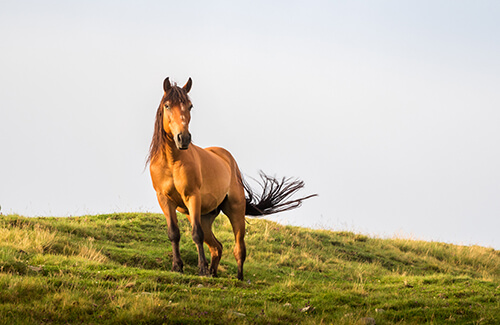What is laminitis?
May 11, 2020

Every day veterinarians across the country see hundreds of cases of laminitis, a painful disease that affects the horse's feet. Laminitis can be a debilitating, and even fatal, disease of the hoof. In the horse, the hoof wall is connected to the coffin bone through a complex arrangement of finger-like projections called laminae. These tissues provide shock absorption and anchor the hoof capsule to the coffin bone.
When the laminae become inflamed, or blood flow to this tissue is disrupted, laminae health deteriorates and the structural support provided by the laminae weakens, allowing the coffin bone to rotate downward or sink. Rotation of the coffin bone is referred to as founder. In severe cases, the coffin bone can actually penetrate the sole of the foot. While laminitis can affect all four feet, it is most commonly seen in the front feet, as the horse bears more than 60 percent of its body weight on the front feet.
A variety of factors are believed to contribute to development of laminitis, including physical or mechanical changes to the hoof (such as trauma, excessive concussion or weight bearing), exposure to black walnut shavings, or a retained placenta following foaling. Endocrine disturbances associated with obesity and the development of insulin resistance in horses have also been implicated as potential causes of laminitis. However, in many cases, laminitis is the result of over-feeding. While most horses can tolerate moderate levels of carbohydrates in their diet, excessive ingestion of non-structural carbohydrates (NSC), including starch, sugars, or fructans can cause metabolic disturbances that result in laminitis.
As horse owners, it is important to monitor our horse’s feed and forage intake. Follow feeding directions on manufactured feeds and do not feed excessive amounts of cereal grains. If large amounts of grain or feed need to be fed for the horse to maintain proper condition, then it is recommended to switch the horse to a more nutrient-dense feed. This allows for feeding a smaller, safer amount of grain or feed (reducing the potential for laminitis) without sacrificing the nutritional needs of the horse.
Gradually introduce horses to spring pastures if they have not been eating fresh forage through the course of the winter. Beyond adapting horses to lush pastures, consider limiting access to these pastures to a few hours per day until the forage is more mature, as immature, rapidly growing forages are high in NSC.
Laminitis can be a devastating disease with long-term implications. However, with proper management, incidences of laminitis can be reduced in normal horses, as well as those predisposed to the disease. For more information, contact your local Co-op!
When the laminae become inflamed, or blood flow to this tissue is disrupted, laminae health deteriorates and the structural support provided by the laminae weakens, allowing the coffin bone to rotate downward or sink. Rotation of the coffin bone is referred to as founder. In severe cases, the coffin bone can actually penetrate the sole of the foot. While laminitis can affect all four feet, it is most commonly seen in the front feet, as the horse bears more than 60 percent of its body weight on the front feet.
A variety of factors are believed to contribute to development of laminitis, including physical or mechanical changes to the hoof (such as trauma, excessive concussion or weight bearing), exposure to black walnut shavings, or a retained placenta following foaling. Endocrine disturbances associated with obesity and the development of insulin resistance in horses have also been implicated as potential causes of laminitis. However, in many cases, laminitis is the result of over-feeding. While most horses can tolerate moderate levels of carbohydrates in their diet, excessive ingestion of non-structural carbohydrates (NSC), including starch, sugars, or fructans can cause metabolic disturbances that result in laminitis.
As horse owners, it is important to monitor our horse’s feed and forage intake. Follow feeding directions on manufactured feeds and do not feed excessive amounts of cereal grains. If large amounts of grain or feed need to be fed for the horse to maintain proper condition, then it is recommended to switch the horse to a more nutrient-dense feed. This allows for feeding a smaller, safer amount of grain or feed (reducing the potential for laminitis) without sacrificing the nutritional needs of the horse.
Gradually introduce horses to spring pastures if they have not been eating fresh forage through the course of the winter. Beyond adapting horses to lush pastures, consider limiting access to these pastures to a few hours per day until the forage is more mature, as immature, rapidly growing forages are high in NSC.
Laminitis can be a devastating disease with long-term implications. However, with proper management, incidences of laminitis can be reduced in normal horses, as well as those predisposed to the disease. For more information, contact your local Co-op!